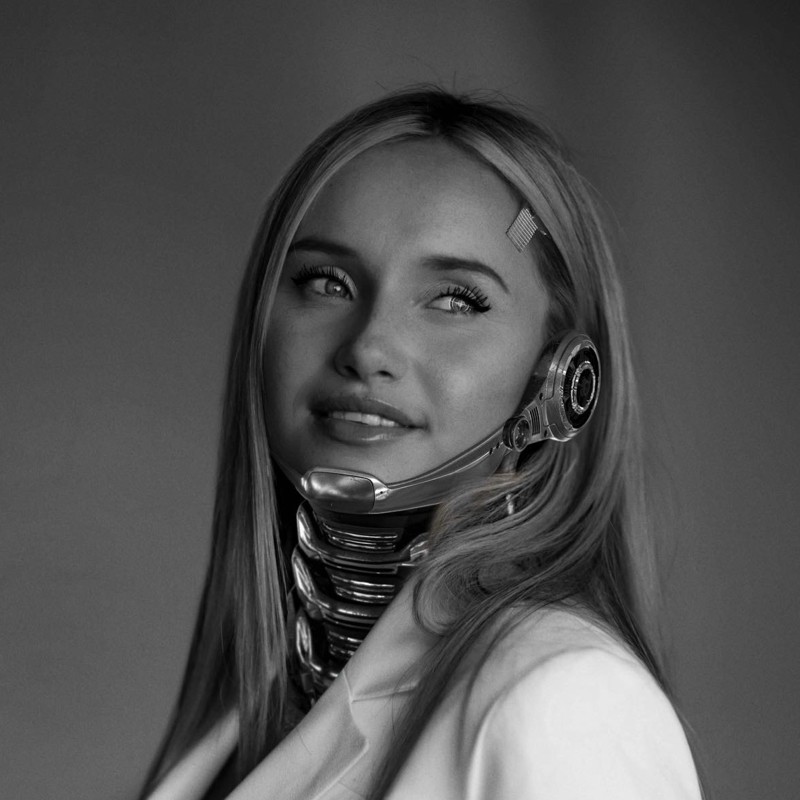This website uses cookies so that we can provide you with the best user experience possible. Cookie information is stored in your browser and performs functions such as recognising you when you return to our website and helping our team to understand which sections of the website you find most interesting and useful.
Your Trusted
Technology
Partner
Delivering custom solutions for sustainable growth

Core technology consulting services
Artificial Intelligence
Unicsoft’s end-to-end approach to implementing AI solutions for businesses begins with consulting and outlining an MVP.
Yuriy, Machine Learning Engineer
Belongs to Kaggle Top 3% world data science professionals.
Machine Learning
Our engineers deliver technology services by applying complex statistical methods and ML algorithms to build end-to-end Machine Learning solutions.
Oleg, Machine Learning Architect
Developed solution architecture for Emirates.
Data Science
We build comprehensive data-driven solutions capable of unlocking intelligent value across business processes and driving stronger performance.
Yuriy, Machine Learning Engineer
Belongs to Kaggle Top 3% world data science professionals.
Natural Language Processing
We assist companies in validating ideas for NLP solutions and creating a comprehensive product roadmap to develop tools for human language processing.
Anton, Machine Learning Consultant
Contributed to first-of-its-kind technology reducing the complexity of dialysis.
Big Data
Within our technology consulting, we provide a full range of Big Data services: Data Warehouse development, data lakes, and applications for data processing.
Alex, Big Data Architect
Designed data storage up to 50 Terabytes.
Data Analytics
Our data engineers provide data analytics consulting services to help companies leverage advanced analytics techniques to extract valuable insight.
Yuriy, Machine Learning Engineer
Belongs to Kaggle Top 3% world data science professionals.
Computer Vision
Unicsoft helps startups and enterprises make custom product designs and develop intelligent computer vision systems with unique requirements.
Yuriy, Machine Learning Engineer
Belongs to Kaggle Top 3% world data science professionals.
Blockchain
Our Blockchain consulting services help shape your idea into a viable product, leveraging the expertise of leaders in distributed ledger technologies.
Artem, Blockchain Architect
Developed a cryptocurrency backed by the Swiss Francs.
What our clients say
Very efficient and reliable resource provider. Quickly reacted to our request and provided an interesting suite of candidates. During the cooperation period always available and ready to help. Overall experience very good. Highly recommended.

Lead Data Architect, MakerDAO
With the support of our partners at Unicsoft, we have created a platform that will provide developers with an efficient way to raise project capital and enable investors to actively choose which carbon offset projects they would like to support. Unicsoft is a highly reliable & efficient development partner, providing excellent project management, timely communication & commitment to go the extra mile when needed.

Co-CEO and Co-Founder, Frontier Carbon Solutions
Thanks to the expertise that the Unicsoft team brought to the table, the company was able to complete the project faster and at a better cost. They did this by using advanced and transparent methodologies that were trustworthy, responsive, friendly, and professional.

Founder & CEO, Deedstack Inc
I’d recommend Unicsoft because I felt their engagement and understanding of our business. They offered the best solution provision of what we were looking for. They were very responsive to the requests, very flexible just going in flow with our changes.

Managing Partner, Octagon, UK
I think that they have a can-do attitude. We threw a lot of requests and a lot of very specific timing requirements at them. They were pretty adaptable and willing to put in extra hours to service us.

Chief Operations Officer, Dashboard Dealership Enterprises, USA
With Unicsoft's help, the client now has the needed capacity to accomplish their ongoing projects. More importantly, the delegated developers have gelled seamlessly with the internal team, resulting in high-quality and timely outputs. Overall, this has been a successful partnership.

CEO, Subscription Service Provider
Whilst we have started the build of a new platform with Unicsoft, we found their capability on Cloud infrastructure configuration and setup to be quite impressive. Specifically, the DevOps team of Unicsoft who are very knowledgeable and were able to build the infrastructure in a cost effective and compliant manner.

CTO, TMA Sports Management Ltd
Lifewatch worked with Unicsoft for 3.5 years, during this time the product was launched and supported for over a year. Unicsoft allocated a team of very professional developers who did a great job for us and we intend to work with Unicsoft more in the future.

SW Group Manager & Architect, LifeWatch, USA-Israel
The ditto and Unicsoft story is a perfect example of partnership in practice. Unicsoft has never let us down. Unicsoft gives us an edge and advantage.

Founder & Creative Director, ditto, UK
I couldn’t be more happy with Unicsoft, their professionalism, and with the result of what they built for my client.

CEO, CrossOceans, USA
Unicsoft quickly supplied talented developers and thoroughly documented the project. The team was knowledgeable, communicative, and committed. They were genuinely interested in ensuring our satisfaction.

CEO, Hackyard Internet AB
I’m very happy with the iOS and Android work Unicsoft performed for me. The quality of code and communications Unicsoft provided has certainly proved they are a capable and trustworthy team of professionals. I would highly recommend them as a highly competent, cost-effective development team.

EVP/COO, Critical RF Inc, USA
Right from the start Unicsoft inspired confidence. They quickly identified the steps necessary to achieve our desired result and gave us regular updates on their progress.

Assistant Property Manager, Conscience Bay Company, USA
We found Unicsoft to be the best partner out there, capable of building a team of professionals that can tackle the technological challenges, deliver great results, innovative solutions and in high quality. Unicsoft turned out to be a flexible and prompt team extension partner. When we needed additional developers for other projects, they’ve quickly provided us with the staff we needed.

CTO at Augmind Ltd
Unicsoft’s ability to deliver high-quality development work on time led to an ongoing partnership. The team met aggressive deadlines and adapted to the client’s work style as needed. Clear communication, proactive decision-making, and a customer-oriented approach are hallmarks of this project.

Former CTO, 4B Group
The engagement helps the client provides a high level of value to their customers. Unicsoft successfully picked up on the nuances of the project and adapted to the working style of the client. The team is hard-working and innovative.

Director of Engagement, AlphaWallet
Our engagement with Unicsoft was very satisfying. They reported everything and delivered the product on time. If there were any issues, they were discussed upfront. They didn’t wait for the problem to occur.

CEO, NRG Software Solutions
We have been highly impressed by the close cooperation, pro-active team, and project execution within the schedule and budget. The intermediate results were demonstrated permanently and transparently every week. Enough attention was paid to documentation, which was really useful for our product's future scalability...

Chief Digital Officer (CDO) at Atlantic Group (AGL)
We were able to quickly grow our staff. As a startup, we couldn’t waste time looking to hire people in every part of our company. But by working with Unicsoft, we were able to rapidly grow our product line and engage with our core customers quicker.

Founder and CTO, Virgil Security, Inc.
Unicsoft was ready to adapt to new challenges as needed even if that meant more learning on their end. The team was managed in a transparent way and we were able to follow the development both in terms of the code and in terms of the user load. Overall, I can say the project management was excellent.

Chief Science & Technology Officer, Ternary Intelligence
Transparency in communication is a fantastic skill for a partner to have. In addition, Unicsoft proved their expertise among a vast range of technologies, which was emphasized by our client. The project manager was extremely responsive. He was available 24/7 to cover all questions and demonstrate progress as needed.

CEO, ADUK GmbH, Germany
I cannot stress how great working with Unicsoft has been. The development team I was using before them required so much hand holding and micromanaging, whereas with Unicsoft I get to sit back and trust that they have everything handled! They are incredibly thorough and organized…so working with Unicsoft is a breathe of fresh air! I will definitely continue to use them in the future. They make it very easy.

VFX & 3D Motion Design Artist at VisualFX
I've been much more satisfied with Unicsoft's work compared to other local providers in North America. They're dedicated, smart, and work with my business, rather than for my business. I've also been very impressed by the quality of their code overall.

Founder, SOSsitter, Canada
A professional, highly skilled and dynamic team was assigned to my project who from day 1 was committed to my projects success! Even during the global lock-down period, they were responsive and quick to provide high-quality deliverables, thank you!

Founder, Concept Stage Project
I can definitely recommend Unicsoft as a reliable partner. They have flexible working approaches, pleasant and dedicated staff, and always trying to solve the problem - not to redirect it. Reasonable price model, technically strong engineers, and quick and efficient staffing process.

COO, GFI
Level of commitment, providing subject matter experts on short notice, and hospitality has given a very positive feeling towards Unicsoft personnel and their business processes.

Co-Founder, Xypher Pte, Singapore
It was excellent. We have never been disappointed. Problems did arise, but Unicsoft maintains a wonderful platform for collaboration through which we found solutions. They really analyzed and tried to understand the business use of the tool I wanted to develop.

Owner, KOKORO, Austria
The PM was always available and we didn't have any issues. The team was flexible and they were offering solutions based on their experience. The developer was going the extra-mile and based on the internal feedback from the in-house team, everyone was extremely satisfied to work with him from the technical perspective as well.

Product Manager, Media Production Company
The people we have worked with at Unicsoft have been knowledgable with our codebase, and have contributed code and suggestions that our entire team finds valuable. We have used Unicsoft with both short term (~1-2 month) and long term (6 month+) projects and in each case, the engineers we work with take ownership and pride in the code that they write. I can't recommend them enough.

Director of Software Engineering at FIGS
We needed a team to bring our idea to life within tight deadlines. We chose Unicsoft for broad expertise and involvement in the project from the beginning. Unicsoft proved deep expertise, readiness to do the extra miles to build the solution within tight deadlines.

Founder at FranceVerif
Unicsoft were key to our engineering development in early phases. They were extremely professional, knowledgeable and acted as a true partner to help build our iOS and Web applications. A number of their team members rose to the challenges and I would like to make specific mention of their iOS developers & account management team who treated our needs as theirs and ensured a timely & superlative output.

Kumar
We commissioned Unicsoft to support us with our web relaunch and redesign project. Apart from the smooth and effective way of working, we were also impressed by their ability to implement our requirements in a targeted manner. Unicsoft understood our brand language and tonality exactly, brought it up to date, and delivered a tailor-made, perfect-fit UI design.

CEO at 123sonography
During almost 5 years of cooperation, the team demonstrated a deep understanding of our company's IT needs and objectives. Your team consistently delivered on their commitments, showcasing remarkable attention to detail, and readily embraced our feedback and incorporated it into their work, ensuring that our vision and objectives were fully aligned. This open and constructive dialogue created an environment of mutual respect and led to the development of innovative solutions that perfectly catered to our evolving needs.

Chief Information Officer at IoT Venture GmbH
We have been working with Unicsoft very successfully for more than 5 years. They are group of very professional, hard working and sympathetic people. Throughout our collaboration the level of customer service has been excellent. Unicsoft has constant access to a wide pool of developers. It’s almost unreal how quickly they find the right persons for our teams and projects. Even if it’s some niche technology.

Working with Unicsoft has been highly constructive and efficient experience. Their dedicated engineer’s skillful integration of testing frameworks, streamlining of test suites, and innovative approach to improving QA Automation framework have enhanced our operational efficiency. I've seen firsthand how team’s technical acumen and dedication to excellence contribute to our project's success and drive continuous improvement. The team has enhanced our QA Automation framework with their technical skills and practical approach.

QA Group Manager at the CTERA Networks
What our clients say
Very efficient and reliable resource provider. Quickly reacted to our request and provided an interesting suite of candidates. During the cooperation period always available and ready to help. Overall experience very good. Highly recommended.
Lead Data Architect, MakerDAO
With the support of our partners at Unicsoft, we have created a platform that will provide developers with an efficient way to raise project capital and enable investors to actively choose which carbon offset projects they would like to support. Unicsoft is a highly reliable & efficient development partner, providing excellent project management, timely communication & commitment to go the extra mile when needed.
Co-CEO and Co-Founder, Frontier Carbon Solutions
Thanks to the expertise that the Unicsoft team brought to the table, the company was able to complete the project faster and at a better cost. They did this by using advanced and transparent methodologies that were trustworthy, responsive, friendly, and professional.
Founder & CEO, Deedstack Inc
I’d recommend Unicsoft because I felt their engagement and understanding of our business. They offered the best solution provision of what we were looking for. They were very responsive to the requests, very flexible just going in flow with our changes.
Managing Partner, Octagon, UK
I think that they have a can-do attitude. We threw a lot of requests and a lot of very specific timing requirements at them. They were pretty adaptable and willing to put in extra hours to service us.
Chief Operations Officer, Dashboard Dealership Enterprises, USA
With Unicsoft's help, the client now has the needed capacity to accomplish their ongoing projects. More importantly, the delegated developers have gelled seamlessly with the internal team, resulting in high-quality and timely outputs. Overall, this has been a successful partnership.
CEO, Subscription Service Provider
Whilst we have started the build of a new platform with Unicsoft, we found their capability on Cloud infrastructure configuration and setup to be quite impressive. Specifically, the DevOps team of Unicsoft who are very knowledgeable and were able to build the infrastructure in a cost effective and compliant manner.
CTO, TMA Sports Management Ltd
Lifewatch worked with Unicsoft for 3.5 years, during this time the product was launched and supported for over a year. Unicsoft allocated a team of very professional developers who did a great job for us and we intend to work with Unicsoft more in the future.
SW Group Manager & Architect, LifeWatch, USA-Israel
The ditto and Unicsoft story is a perfect example of partnership in practice. Unicsoft has never let us down. Unicsoft gives us an edge and advantage.
Founder & Creative Director, ditto, UK
I couldn’t be more happy with Unicsoft, their professionalism, and with the result of what they built for my client.
CEO, CrossOceans, USA
Unicsoft quickly supplied talented developers and thoroughly documented the project. The team was knowledgeable, communicative, and committed. They were genuinely interested in ensuring our satisfaction.
CEO, Hackyard Internet AB
I’m very happy with the iOS and Android work Unicsoft performed for me. The quality of code and communications Unicsoft provided has certainly proved they are a capable and trustworthy team of professionals. I would highly recommend them as a highly competent, cost-effective development team.
EVP/COO, Critical RF Inc, USA
Right from the start Unicsoft inspired confidence. They quickly identified the steps necessary to achieve our desired result and gave us regular updates on their progress.
Assistant Property Manager, Conscience Bay Company, USA
We found Unicsoft to be the best partner out there, capable of building a team of professionals that can tackle the technological challenges, deliver great results, innovative solutions and in high quality. Unicsoft turned out to be a flexible and prompt team extension partner. When we needed additional developers for other projects, they’ve quickly provided us with the staff we needed.
CTO at Augmind Ltd
Unicsoft’s ability to deliver high-quality development work on time led to an ongoing partnership. The team met aggressive deadlines and adapted to the client’s work style as needed. Clear communication, proactive decision-making, and a customer-oriented approach are hallmarks of this project.
Former CTO, 4B Group
The engagement helps the client provides a high level of value to their customers. Unicsoft successfully picked up on the nuances of the project and adapted to the working style of the client. The team is hard-working and innovative.
Director of Engagement, AlphaWallet
Our engagement with Unicsoft was very satisfying. They reported everything and delivered the product on time. If there were any issues, they were discussed upfront. They didn’t wait for the problem to occur.
CEO, NRG Software Solutions
We have been highly impressed by the close cooperation, pro-active team, and project execution within the schedule and budget. The intermediate results were demonstrated permanently and transparently every week. Enough attention was paid to documentation, which was really useful for our product's future scalability...
Chief Digital Officer (CDO) at Atlantic Group (AGL)
We were able to quickly grow our staff. As a startup, we couldn’t waste time looking to hire people in every part of our company. But by working with Unicsoft, we were able to rapidly grow our product line and engage with our core customers quicker.
Founder and CTO, Virgil Security, Inc.
Unicsoft was ready to adapt to new challenges as needed even if that meant more learning on their end. The team was managed in a transparent way and we were able to follow the development both in terms of the code and in terms of the user load. Overall, I can say the project management was excellent.
Chief Science & Technology Officer, Ternary Intelligence
Transparency in communication is a fantastic skill for a partner to have. In addition, Unicsoft proved their expertise among a vast range of technologies, which was emphasized by our client. The project manager was extremely responsive. He was available 24/7 to cover all questions and demonstrate progress as needed.
CEO, ADUK GmbH, Germany
I cannot stress how great working with Unicsoft has been. The development team I was using before them required so much hand holding and micromanaging, whereas with Unicsoft I get to sit back and trust that they have everything handled! They are incredibly thorough and organized…so working with Unicsoft is a breathe of fresh air! I will definitely continue to use them in the future. They make it very easy.
VFX & 3D Motion Design Artist at VisualFX
I've been much more satisfied with Unicsoft's work compared to other local providers in North America. They're dedicated, smart, and work with my business, rather than for my business. I've also been very impressed by the quality of their code overall.
Founder, SOSsitter, Canada
A professional, highly skilled and dynamic team was assigned to my project who from day 1 was committed to my projects success! Even during the global lock-down period, they were responsive and quick to provide high-quality deliverables, thank you!
Founder, Concept Stage Project
I can definitely recommend Unicsoft as a reliable partner. They have flexible working approaches, pleasant and dedicated staff, and always trying to solve the problem - not to redirect it. Reasonable price model, technically strong engineers, and quick and efficient staffing process.
COO, GFI
Level of commitment, providing subject matter experts on short notice, and hospitality has given a very positive feeling towards Unicsoft personnel and their business processes.
Co-Founder, Xypher Pte, Singapore
It was excellent. We have never been disappointed. Problems did arise, but Unicsoft maintains a wonderful platform for collaboration through which we found solutions. They really analyzed and tried to understand the business use of the tool I wanted to develop.
Owner, KOKORO, Austria
The PM was always available and we didn't have any issues. The team was flexible and they were offering solutions based on their experience. The developer was going the extra-mile and based on the internal feedback from the in-house team, everyone was extremely satisfied to work with him from the technical perspective as well.
Product Manager, Media Production Company
The people we have worked with at Unicsoft have been knowledgable with our codebase, and have contributed code and suggestions that our entire team finds valuable. We have used Unicsoft with both short term (~1-2 month) and long term (6 month+) projects and in each case, the engineers we work with take ownership and pride in the code that they write. I can't recommend them enough.
Director of Software Engineering at FIGS
We needed a team to bring our idea to life within tight deadlines. We chose Unicsoft for broad expertise and involvement in the project from the beginning. Unicsoft proved deep expertise, readiness to do the extra miles to build the solution within tight deadlines.
Founder at FranceVerif
Unicsoft were key to our engineering development in early phases. They were extremely professional, knowledgeable and acted as a true partner to help build our iOS and Web applications. A number of their team members rose to the challenges and I would like to make specific mention of their iOS developers & account management team who treated our needs as theirs and ensured a timely & superlative output.
Kumar
We commissioned Unicsoft to support us with our web relaunch and redesign project. Apart from the smooth and effective way of working, we were also impressed by their ability to implement our requirements in a targeted manner. Unicsoft understood our brand language and tonality exactly, brought it up to date, and delivered a tailor-made, perfect-fit UI design.
CEO at 123sonography
During almost 5 years of cooperation, the team demonstrated a deep understanding of our company's IT needs and objectives. Your team consistently delivered on their commitments, showcasing remarkable attention to detail, and readily embraced our feedback and incorporated it into their work, ensuring that our vision and objectives were fully aligned. This open and constructive dialogue created an environment of mutual respect and led to the development of innovative solutions that perfectly catered to our evolving needs.
Chief Information Officer at IoT Venture GmbH
We have been working with Unicsoft very successfully for more than 5 years. They are group of very professional, hard working and sympathetic people. Throughout our collaboration the level of customer service has been excellent. Unicsoft has constant access to a wide pool of developers. It’s almost unreal how quickly they find the right persons for our teams and projects. Even if it’s some niche technology.
Working with Unicsoft has been highly constructive and efficient experience. Their dedicated engineer’s skillful integration of testing frameworks, streamlining of test suites, and innovative approach to improving QA Automation framework have enhanced our operational efficiency. I've seen firsthand how team’s technical acumen and dedication to excellence contribute to our project's success and drive continuous improvement. The team has enhanced our QA Automation framework with their technical skills and practical approach.
QA Group Manager at the CTERA Networks
Want to discuss implementing the latest technologies into your solution? Talk to our Unicsoft technology consulting team today!
Talk to our consultantWhat challenge are you facing?
We deliver technology consulting services for both startups and enterprises to drive results with business-led solutions and framework-based technology services.
We will help validate your idea, build an MVP, and iterate towards reaching product-market fit. We will increase your time to market by 30%, reduce development costs, and secure a timely product launch.
Learn moreTechnology consulting for enterprises involves building business-led solutions and energizing legacy systems that drive business performance and constrain inefficiencies – letting you save up to 60% on overhead costs.
Learn moreOur work
Seeking consulting services on how to develop a software product that drives targeted business outcomes?
Contact our expertWe Have Great Industry Expertise in
Healthcare
Unicsoft offers digital strategy consulting for healthcare providers to implement solutions for higher operations efficiency and better patient outcomes.
Learn moreAutomotive
Our digital strategy consulting empowers automotive companies to optimize sales, enhance operations, and predict malfunction leveraging technologies.
Learn moreFintech
We provide financial services for organizations to leverage the latest technologies that optimize operations, improve security, and manage risks.
Learn moreSupply Chain
We assist enterprises in creating transparency and guaranteeing safety throughout the entire supply chain using Blockchain solutions.
Learn moreMarketing & Media
Being a consulting company, we drive digital transformation in marketing to optimize customer analysis and enrich companies with actionable insight.
Learn moreRetail & E−commerce
Unicsoft business services help retail companies adopt new ways of customer engagement and retention, transforming the customer experience.
Learn moreWhy do customers trust us?
15 years
of applied experience in technology consulting and software development
TOP 1
in Artificial Intelligence by Clutch and Goodfirms and Blockchain Development
Top 3%
world data science professionals by Kaggle includes Unicsoft experts
Our Approach
Unicsoft is a technology consulting company, addressing excellent customer experience as our highest priority. We achieve it via clear and timely communication, transparency in managing customers’ expectations, a highly orchestrated development process, and a pro-active and consistent team.
We continuously drive the sustainable growth of our customers, team, and ecosystem altogether – with care, commitment, and excellence.
Aleksey Zavgorodniy
Chief Executive Officer
